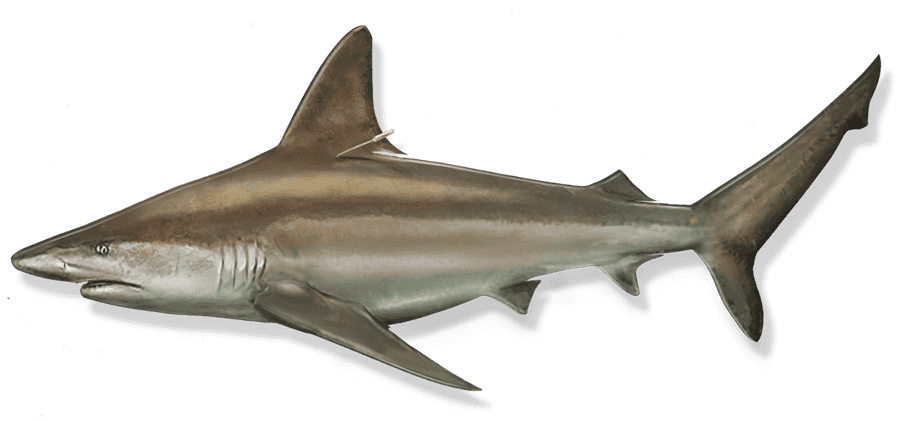Sandbar Shark

Species Details
Carcharhinus Plumbeus
Carcharhinidae
Carcharhiniformes
Continental Shelves, Oceanic Banks
143 - 260 lbs.
20" - 71"
Sandbar Shark (Carcharhinus plumbeus) Fish Description
A Sandbar Shark is a member of the requiem sharks and known for its tall dorsal fins. They also have an interdorsal ridge which other sharks don’t have. Sandbar Sharks are considered one of the biggest coastal sharks in the world. They’re also cousins with the Bull Sharks, Bignose Sharks, and, the Dusky Sharks. Sandbar Sharks are also known for their brown or gray color with a white underbelly.
Another thing that sets them apart from other sharks is their bodies being quite heavy. They also have shorter snouts than a regular shark. Their upper teeth have broad but uneven, sharp cusps. Their second dorsal fin – the one near its deeply forked tail fin – is almost the same height as its anal fin.
Diet and Size
Sandbar Sharks eat a variety of fish, rays, and crabs. They eat bony fishes, eels, skates, and dogfish. They also eat octopuses, squids, and shrimps.
Sandbar Sharks are sexually dysmorphic in terms of size. Females can grow up to 6.6 to 8.2ft whereas males can grow up to 5.9ft.
Interesting Facts
- Sandbar Sharks are not dangerous to humans.
- Sandbar Sharks reproduce every 2 to 3 years.
- These sharks gained their name due to their habitat of choice: sandy flats, bays, and estuaries.
- Sandbar Sharks are often preyed upon by other sharks such as Tiger Sharks. Rarely, even Great White Sharks.
- These Sandbar Sharks can live up to 35-41 years.
Fishing Techniques: How to Fish for a Sandbar Shark
Since these sharks are big, people recommend using heavy tackle. And don’t buy the cheap ones! When it comes to fishing for Sandbar Sharks, people recommend using at least a 65-lbs to bring in one of these big sharks. One thing about fishing for a Sandbar Shark is that you need to build a Shark Rig. Basic Shark Rigs usually have crimps, a large 9/0 or 12/0 hook with a 200-lbs minimum swivel attached. Though, you can try experimenting and see what gets you your shark.
As for bait, the best thing to use is live, fresh bait. Like any shark, the Sandbar Shark relies on smell to hunt its food. People recommend skates, eels, sea bass, squid, and some crustaceans. But one of the best baits – according to most anglers – is Bluegill. It’s easy to find, oily, and smelly which makes it ideal for the Sandbar Sharks.
Sandbar Sharks put up a pretty good fight. They would grab the bait and run off with it so they’ll attempt to drag the bait down, indirectly you with it! So, having quality equipment is a must especially when putting a fight with the Sandbar Shark. Once they’re hooked, however, lure and lead them to the sandy coasts where you can easily haul them over the coast. And do so gently, roughly will have them slapping you with their tail and unintentionally injuring you.
Habitat and Distribution
Sandbar Sharks are usually around the Western Atlantic. They stay in temperate waters and can sometimes migrate to the Eastern Atlantic. They sometimes swim to the Persian Gulf, Red Sea, South, and East Africa waters, to the Hawaiian Islands. They hang around the Galapagos Islands as well.
In those waters, these Sandbar Sharks may be loitering around the sandy coasts. They don’t stay near the surface of the water. Rather, they prefer staying in waters near continental shelves or oceanic banks. They stay in waters that are at least 60-200 ft deep.







